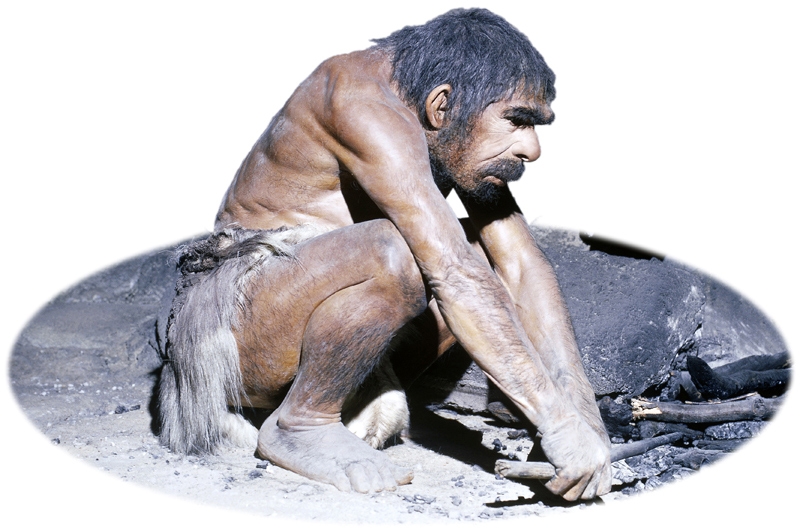The human species that today makes astounding advances in technology, and particularly in the medical field, did not exist four million years ago. In fact, hominids of that period were very different from the modern species in many ways. How did humans evolve to become today’s humans? How did Homo sapiens become so innovative? For one, they developed favorable qualities that were essential for adaptation and a thriving existence.

Homo sapiens derived from a form of early humans called Neanderthal. Unlike modern humans, characteristics of the Neanderthal included occipital buns and protruded brow ridges.1 One important facial feature of the Neanderthal was their large nose for “humidifying and warming cold, dry air” before it reached the lungs.2 Modern humans do not have this characteristic due to the fact that the Neanderthals lived in much harsher conditions. Thanks to the work of archaeologists and anthropologists, we know a great deal about the life and world of Neanderthals. The first fossils of these humans were found in France, and scholars have since called these humans Cro-Magnon. They created innovative tools from bones and antlers for hunting. This enabled them to survive and thrive in their environment. They even created artwork “in the form of decorated tools, beads, ivory carvings of humans and animals, clay figurines, musical instruments, and cave paintings.”3

Homo sapiens originated from East Africa. From there homo sapiens have migrated to all of earth’s main land masses. By taking advantage of land bridges, they have spread to Indonesia, New Guinea, Australia, and the Americas. Another contributing factor to the spreading of humans was the recent major Ice Age. The freezing of the oceans’ waters around the polar caps lowered the sea level, which exposed land bridges between land masses that were otherwise under water. For example, the connection between Calabria and Sicily had a sea level around -126 meters.4 They were able to adapt to the different environments due to their larger brain capacities, hence more intelligence. Having the knowledge that they had, they were able to create warm clothes and shelters to survive under various harsh conditions in the regions they occupied. Since they were nomadic people, there was no economic prosperity during the Paleolithic era. This was due to the fact that they never inhabited an area for a long duration of time. They were foragers; they scrapped up whatever they could find for survival, so there was no time period in which they could accumulate wealth. With that being said, that meant that there were no social classes. Instead, they lived an egalitarian lifestyle. While the men hunted, the women gathered. This method sustained their existence until the Neolithic Revolution, which domesticated both plants and animals.
The evolution of earlier hominids to Homo sapiens opened the door to a species capable of more advanced thinking about their surroundings and survival. The human race has since continued to thrive to the present. Without their innovative tools, body structures, and eventually domestication of plants and animals, Homo sapiens would not have been able to produce the advancements in technology and sciences that we have available today.
- Markus Bastir, Paul O’Higgins, and Antonio Rosas, “Facial Ontogeny in Neanderthals and Modern Humans,” Proceedings of the Royal Society B: Biological Sciences 274, no. 1614 (May 7, 2007): 1125–32. ↵
- Todd C. Rae, Thomas Koppe, and Chris B. Stringer, “The Neanderthal Face Is Not Cold Adapted,” Journal of Human Evolution 60, no. 2 (February 2011): 234–239. ↵
- “Evolution: Humans: Origins of Humankind.” Accessed September 10, 2016. http://www.pbs.org/wgbh/evolution/humans/humankind/o.html. ↵
- Fabrizio Antonioli, V. Lo Presti, M. G. Morticelli, M. A. Mannino, Kurt Lambeck, Luigi Ferranti, Catriona Bonfiglioli, et al., “The Land Bridge between Europe and Sicily over the Past 40 Kyrs: Timing of Emersion and Implications for the Migration of Homo Sapiens,” Rendiconti Online Societa Geologica Italiana, 2012. https://openresearch-repository.anu.edu.au/handle/1885/71477. ↵



99 comments
Daniel Gimena
It is fascinating to learn from were humans come from. It is incredible to see what the human race as accomplished in a little period of time, speaking in geographical time. The various differences between those first humans called Homo sapiens and us, show us how humans adapt to our needs in a specific environment. One thing that has caught my attention is the fact that Homo Sapiens had larger noses, in order to humidifying and warming cold, dry air.
When we study our past, many times we are able to learn important things about ourselves, hence the importance of the work of archeologists, historians, etc.
Maria Luevano
This article was such an interesting read on the evolution of the human species and what their capabilities were! I do not know much about the origins and history of humans, so I am glad the author was able to provide such detailed information. It is so fascinating how neanderthals turned to homo sapiens, then eventually evolved to us, human beings.
Skyla Bonilla
I decided to read this article because i was interested in evolution and I’m glad I decided to read it because it was so interesting to see how humans evolved. I really enjoyed reading about the neanderthals and I had no idea they were capable of doing things such as hunting and creating art. The author did a great job of sharing how humans have evolved into what they are today!
Sehar Sohail
I always like to learn about evolution, I think this topic is interesting. Many people believe that humans have not evolved I do not think that is true. This article shows and explains how humans used to live before, we used to live among animals just trying to survive. As the years have past humans have changed in many ways their appearance has changed their brains as well have developed, they are much smarter than how they were. I believe we will evolve more in the future in terms of many things.
Yaniev Ibarra
I found fascinating how and why humans evolved. Humans became intelligent and more capable of doing things. I never knew the Neanderthals prior to this article. I learned about the reasons behind these different features. The Ice Age was one of the main contributors to our evolution, which is crazy because I always connected the Ice Age to the movie. I wonder if there will be a next event that will cause us to evolve, which is crazy to think about.
Alexis Lopez
I really enjoyed reading this article and learning more about the Human Race and the evolution process. I thought it was interesting learning about Neanderthal and how they had larger noses for humidifying the air before it was able to reach their lungs. This is something that we don’t see in humans today. I find that very interesting because it goes to show how much humans have evolved and adapted to the world today. Soki Salazar does a great job of giving all the information you need to learn about the evolution of the human race.
Lesley Martinez
It’s always so interesting to learn about the origins of humans. The characteristics of the Neanderthals, such as the large nose is intriguing and explains a lot. Humans are a unique specie as our early ancestors were able to adapt to the new environments that they were faced with and enhance their brain capacities. It’s outrageous how far homo sapiens were able to go, from living for survival to enhancing the world and still waiting to see what the future holds for us.
Meadow Arriaga
For the short amount humans have been on Earth, humans have quickly evolved. Humans at one point had to survive in the wild just as animals, which I learned are called Homo sapiens. It’s refreshing to be reminded of how far humans as a species has come, even in a physical way. Looking at the picture provided, it is obvious there are minor changes to the skulls the average human has nowadays.
Juan Arceo
It has always intrigued as to how the origins of homo sapiens actually came about. I would always want to know more about my roots that go way farther than simply just my grandparents. Thanks to this article however, I was introduced to the term of hominids which I was never aware about. Overall only time will tell until we evolve even more and eventually change our current state of mind.
Jesus Parker
Amazing article about our “ancestors”. I always loved learning about evolution specifically human evolution. There is a specific reason why he has certain body parts because they all serve a function or if not they used to serve for a specific function such as our wisdom teeth. It was cool to read about why Neanderthals had large noses because they needed them to be large to serve a function.